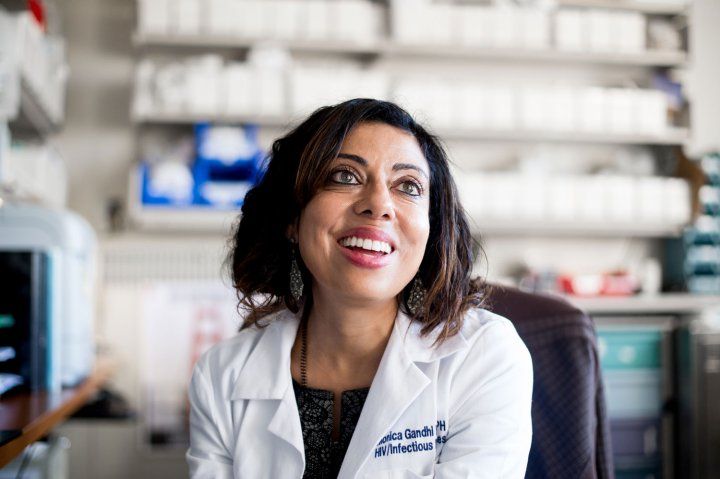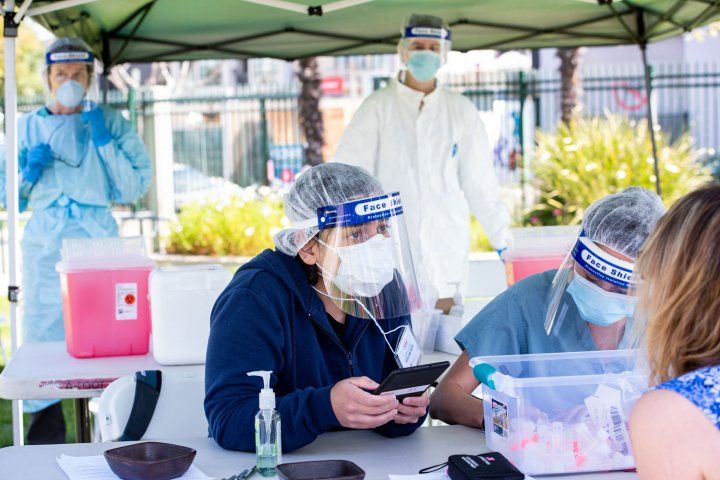How San Francisco’s AIDS Epidemic Response Prepared the City for COVID-19

Diane Havlir, MD. Photo by Steve Babuljak
You had to be an optimist to be an HIV/AIDS doctor or researcher in the early years of that epidemic. Those who were drawn to San Francisco, especially – the epicenter of the new, mysterious, untreatable disease causing so much suffering, fear, and political division – had to believe that they could make things better.
In 1984, Diane Havlir, MD, graduated from Duke medical school and moved across the country for a residency at UC San Francisco. That was the year the San Francisco Chronicle published a special issue titled, “The Year of the Plague.”
“I specifically really wanted to go to UCSF to be on the cutting edge of the AIDS epidemic,” said Havlir. “It was like running towards the fire.”
By the time Monica Gandhi, MD, MPH, arrived, a decade later, the optimism was beginning to pay off. Her intern year, 1996, was the first time that newly diagnosed AIDS cases in the U.S. decreased since the beginning of the epidemic. Highly active antiretroviral therapy (HAART) had just recently become available.
“I was watching people get on effective treatments, and it was like Lazarus rising from the dead. I could see people get well and it was amazing,” she said.
That first year at UCSF made her “feel completely optimistic about the power of everyone coming together and the power of science to combat disease,” said Gandhi, who is now director of the UCSF Center for AIDS Research and medical director of Ward 86.
Now in 2020, as the world faces another new virus stoking fear and uncertainty, San Francisco may be uniquely up to the challenge. Strong ties between UCSF, local government agencies and community groups, forged in the fire of the AIDS epidemic, and a deep bench of infectious disease expertise, has helped the city flatten the curve and better understand this new disease.
“We have a profoundly strong HIV research and HIV treatment community in San Francisco, not just at UCSF but across the city, including the Department of Public Health,” said Gandhi. “This second viral pandemic hits, and everyone’s turning towards COVID research. That means there’s an incredibly robust response from San Francisco towards the COVID pandemic.”
Different Disease But With Parallels
Though the courses of the two diseases are vastly different, Gandhi sees important parallels between COVID-19 and AIDS. Both are social diseases caused by an RNA virus, and both have disproportionately affected marginalized groups. So it’s no surprise that HIV/AIDS specialists have been the first to pivot to COVID-19.

Monica Gandhi, MD. Photo by Noah Berger
A small group of UCSF experts, including Havlir, who is now chief of the HIV, Infectious Disease and Global Medicine division at Zuckerberg San Francisco General, serve on a policy advisory group that has weekly calls with the city about COVID-19 response. As in the early years of the AIDS epidemic, there’s a constant stream of new data and research to parse and new misconceptions to dispel. Not many city health departments have such a close relationship with an academic medical center like UCSF.
When Havlir’s team sought to understand community level transmission of COVID-19 in San Francisco’s Mission District, she reached out to the city’s Latino Taskforce on COVID-19, Grant Colfax, MD, director of the city’s Department of Public Health, and Supervisor Hillary Ronen to seek their support.
“The community leadership is front and center in population-level research. They have the community trust, knowledge and expertise that is foundational,” said Havlir. It was inspirational, she said, to see everyone’s desire to contribute, including the local community, the city, UCSF, and the lab of Joe Derisi, PhD, at the Chan Zuckerberg Biohub.
“One person can’t do everything, but everyone can do something.,” she said.

UCSF, in partnership with the San Francisco Department of Public Health and the city's Latino Taskforce for COVID-19, provided free COVID-19 testing in the Mission District.
With community support, the campaign tested nearly 4,000 residents and workers in the Mission over four days in late April and found that infection rates were nearly 20-fold higher in Latinx than non-Latinx participants (3.9 percent vs. 0.2 percent), and 3.5 times higher for non-resident workers than for residents (6 percent vs. 1.7 percent).
Havlir said it’s essential that research leads to actions that directly help the community. The testing campaign connected people who tested positive with medical care, food assistance and other services to help them self-isolate. And as a result of that study, Supervisor Ronen launched the Right to Recover program, which guarantees up to four weeks of paid wages to anyone who tests positive and does not have alternative income or benefits during the recovery period.
“That to me is such a concrete example of what San Francisco does: a partnership between community, UCSF, political leaders and policymakers to rapidly generate and share data that advances science and leads to policy change that affects the health of a community,” said Havlir.
Another UCSF team, led by Michael Reid, MD, has been working closely with the city’s Department of Public Health to train contact tracers, many of them city employees whose normal jobs have been interrupted by the pandemic
These partnerships have extended to the state level as well, with UCSF launching a statewide contact tracing program with the California Department of Public Health and offering free COVID-19 test analysis to all 58 counties in California.
Infectious Diseases’ Impact on Vulnerable People
The disparities in COVID-19 are a reminder of the disparities in HIV, hitting hardest in communities in the margins. “The world is sort of discovering anew that infectious diseases tend to always seek out the vulnerable and always affect those with social vulnerabilities first, and this is happening with COVID-19,” said Gandhi.
The world is sort of discovering anew that infectious diseases tend to always seek out the vulnerable and always affect those with social vulnerabilities first, and this is happening with COVID-19
Havlir has dedicated years to tackling disparities in HIV/AIDS here and abroad, including co-leading, with Susan Buchbinder, MD, San Francisco’s Getting to Zero initiative, which has the ultimate goal of “zero deaths, zero infections, and zero stigma” from HIV. In 2018, the initiative helped the city reach a record low of 197 new cases of HIV. Those new cases disproportionately affected Latinx and Black residents as well as the homeless population.
Of concern now are signs that the COVID-19 pandemic will affect HIV transmission rates and the health of those living with HIV. Social isolation from shelter-in-place may mean that people are not going to clinic or taking their medications, said Gandhi.
Gandhi is co-chairing the AIDS2020 conference, which, due to the pandemic, will be held virtually, and will include a free COVID-19 conference at the end.
Perhaps what AIDS did for San Francisco, in building community, empathy and a coalition approach to public health, COVID-19 will do for many more cities across the world.
“What HIV did for San Francisco is make it progressive. And it made it compassionate. And it made it into a place that people wanted to come because they felt more comfortable here. And if that could occur everywhere, because suddenly our eyes are being opened, then that would be a profoundly amazing outcome of this entire pandemic,” said Gandhi.